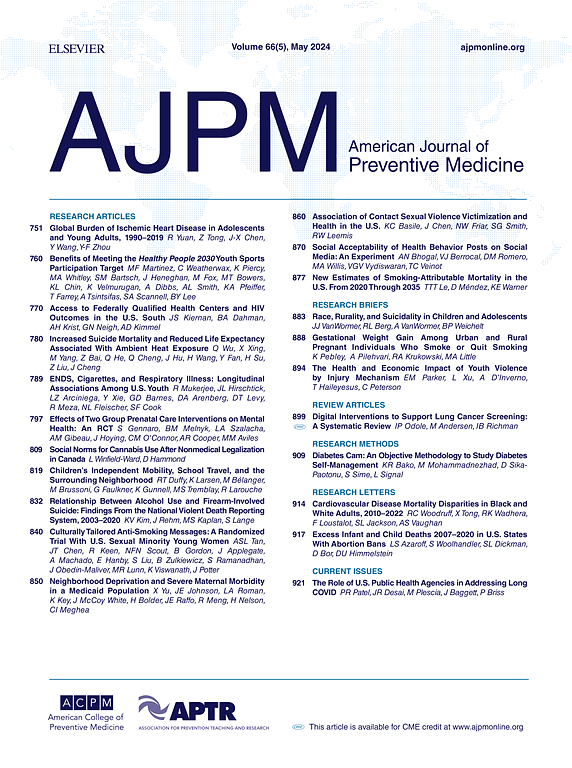美国 75 家大型连锁餐厅 2013-2021 年肉类与无肉菜品的供应趋势和营养概况。
IF 4.3
2区 医学
Q1 MEDICINE, GENERAL & INTERNAL
引用次数: 0
摘要
导言:在美国,连锁餐馆无处不在。虽然餐馆越来越多地推广注重健康和气候的菜单选择,但很少有研究探讨餐馆是否增加了对气候影响较小的菜单项目,以及这些项目是否更健康。本研究探讨了 2013-2021 年间美国 75 家大型连锁餐厅菜单上不同肉类来源食品的供应趋势和营养状况:本研究从 MenuStat.org 网站获取了美国 75 家大型连锁餐厅 2013-2021 年菜单菜品的纵向数据,MenuStat.org 是一个在线数据库,收录了美国收入最高的连锁餐厅的菜单菜品。我们按食品类别和餐厅类型计算了不同肉类来源食品的年度总数量和比例。使用带有聚类标准误差的线性回归模型计算了肉类食品和无肉食品之间的预测平均卡路里差异(总体、按餐厅类型、按年份):肉类食品与无肉类食品的供应量和卡路里含量随着时间的推移基本保持稳定。含鸡肉菜品的供应量有所增加,含牛肉菜品的供应量绝对减少(P-趋势结论):虽然无肉菜品的热量更低,营养成分的某些方面也更有利,但大型连锁餐厅的无肉菜品供应量并未增加,这表明在减少气候影响方面的改善有限。本文章由计算机程序翻译,如有差异,请以英文原文为准。
Trends in Availability and Nutritional Profile of Meat-Based Versus Meat-Free Menu Items in 75 Large Chain Restaurants in the United States, 2013–2021
Introduction
Chain restaurants are ubiquitous in the U.S. While restaurants are increasingly promoting health- and climate-conscious menu options, few studies have examined whether restaurants are increasing availability of menu items with lower climate impact and whether these offerings are healthier. This study examines trends in the availability and nutritional profile of food items featuring different meat sources on menus at 75 large chain restaurants in the U.S. from 2013 to 2021.
Methods
Longitudinal data on menu items from 75 large U.S. chain restaurants from 2013 to 2021 were obtained from MenuStat.org, an online database of menu items from the largest-grossing restaurant chains in the U.S. Annual counts and proportions of food items featuring different meat sources were calculated overall, by food category, and by restaurant type. Differences in predicted mean calories between meat-based items and meat-free items were calculated (overall, by restaurant type, by year) using linear regression models with clustered standard errors.
Results
Availability and calorie content of meat-based versus meat-free items were generally stable over time. Availability of chicken-containing items increased and there was an absolute reduction in the availability of beef-containing menu items (p-trends<0.001). Total calories and calories from protein, unsaturated fat, and saturated fat were lower among meat-free items versus meat-based items. However, calories from sugar were higher for meat-free items.
Conclusions
While meat-free items had fewer calories and some aspects of nutritional profile were more favorable, the availability of meat-free menu items has not increased in large chain restaurants, suggesting limited improvement on reducing climate impact.
求助全文
通过发布文献求助,成功后即可免费获取论文全文。
去求助
来源期刊

American Journal of Preventive Medicine
医学-公共卫生、环境卫生与职业卫生
CiteScore
8.60
自引率
1.80%
发文量
395
审稿时长
32 days
期刊介绍:
The American Journal of Preventive Medicine is the official journal of the American College of Preventive Medicine and the Association for Prevention Teaching and Research. It publishes articles in the areas of prevention research, teaching, practice and policy. Original research is published on interventions aimed at the prevention of chronic and acute disease and the promotion of individual and community health.
Of particular emphasis are papers that address the primary and secondary prevention of important clinical, behavioral and public health issues such as injury and violence, infectious disease, women''s health, smoking, sedentary behaviors and physical activity, nutrition, diabetes, obesity, and substance use disorders. Papers also address educational initiatives aimed at improving the ability of health professionals to provide effective clinical prevention and public health services. Papers on health services research pertinent to prevention and public health are also published. The journal also publishes official policy statements from the two co-sponsoring organizations, review articles, media reviews, and editorials. Finally, the journal periodically publishes supplements and special theme issues devoted to areas of current interest to the prevention community.
 求助内容:
求助内容: 应助结果提醒方式:
应助结果提醒方式:


